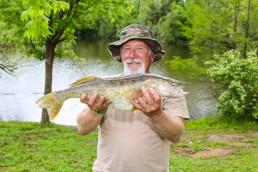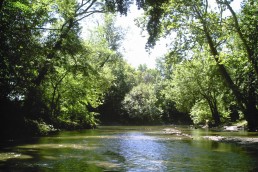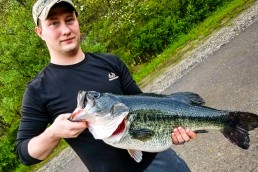Elkhorn Creek: A Bluegrass State Best Bet for Bronzebacks
SHARE THIS POST
In the heart of Kentucky’s Bluegrass Country—a region known for fine horses and smooth bourbon—Elkhorn Creek weaves its way along a course of wild and scenic beauty. Stretches of whitewater, long riffles, deep pools and undercuts offer diverse areas of protection where smallmouth grow old and large. There are numbers, too, making the Elkhorn a popular destination for Kentuckian fly-fishermen and their neighbors.
The Elkhorn begins as two forks. The North Fork’s origin lies east of Lexington, while the South’s is found southwest of the same city. The two merge at the aptly named, Forks of the Elkhorn, just east of Frankfort, the state capital.
Neil Potter, of Delamere & Hopkins Fly Shop in Cincinnati, says, “Elkhorn Creek is one of the hidden gems of the Midwest. It offers world class smallmouth fishing in a small stream setting.”
When asked to define what he considers “world-class” about the Elkhorn, Potter said, “On good days, you can catch 15 to 20 smallmouth over 12 inches. On great days, you’re hauling in upwards of 40 fish that size, with a handful topping 18 inches. I’d be happy with a day like that anywhere.”
So would most anglers I know, which is why a number of fly-fishermen from states like Indiana, Ohio, and West Virginia make frequent trips to the Elkhorn.
Ed Councill founded Canoe Kentucky, a canoe livery on the Elkhorn, 28 years ago. To this day, he has never felt a desire to move anyplace else.
“All streams have their ups and downs,” Councill said. “But lately, things have been real good here on the Elkhorn. I attribute a lot of that to the slot limit Kentucky Fish & Wildlife has in place on the creek, and my general perception that the fishermen who come here have changed. We see a lot more catch-and-release, and much more use of barbless hooks, nowadays.”
The slot limit Councill speaks of demands the release of all smallmouth between 12 and 16 inches. The normal Kentucky limit of six black bass still applies to the Elkhorn, however, of a total limit of six, only two can be longer than 16 inches, so at least four of a daily limit must be less than 12 inches. Hopefully, this isn’t an issue for most, and anglers will release the Elkhorn’s prized bronzebacks, regardless of their size.
Are you enjoying this post?
You can be among the first to get the latest info on where to go, what to use and how to use it!
Lee McClellan of Kentucky Afield magazine, the official publication of the Kentucky Department of Fish and Wildlife, fly-fishes Elkhorn Creek often.
“The Elkhorn is on an upswing,” McClellan said. “When a creek has a three to four year run of good, productive spawning, you can usually expect great fishing four to six years down the road. The Elkhorn is right on the edge of one of those really good periods.”
Not only is the Elkhorn on course for good numbers of smallmouth, but anglers can expect to find more big fish in the near future, as well.
“Data our (Kentucky F&W) biologists gathered during recent shocking surveys shows the highest number of smallmouth over 16 inches ever recorded from the Elkhorn,” McClellan said.
If there’s a downside to the Elkhorn, it’s access. There isn’t a lot of public property or walk-in opportunity. Wade fisherman can enter the creek from two Fish and Wildlife properties: T.N. Sullivan Wildlife Management Area and Peter W. Pfeiffer Fish Hatchery, both located just off U.S. Highway 127 a few miles north Frankfort. The best way to access the creek, though, is by canoe, kayak or raft. Canoe Kentucky is the leading source of rentals on the creek. Both Canoe Kentucky and Delamere & Hopkins provided guided fly-fishing trips.
Old smallmouth staples, Clouser Minnows and Wooly Buggers are flies an angler should have in their box when angling the Elkhorn. But a few local flies, like the Blue Dixie Devil popper and the D&H Cray are quite popular, too. Chartreuse, olive and black were colors mentioned to be effective by all three of the above anglers.
Kentucky may not be the first state eastern fly-fishermen think of when pondering a trip to explore new waters, but Elkhorn Creek is one Bluegrass water worth the drive.
MWO
SHARE THIS POST
Did you enjoy this post?
You can be among the first to get the latest info on where to go, what to use and how to use it!
Brandon Butler
As past executive director of the Conservation Federation of Missouri, Brandon Butler has made a name for himself by fighting to protect fish and wildlife, and critical habitats. His syndicated column, “Driftwood Outdoors,” appears in more than 30 newspapers, weekly, across Missouri and Indiana. Reach him via email at bbutler@driftwoodoutdoors.com.



